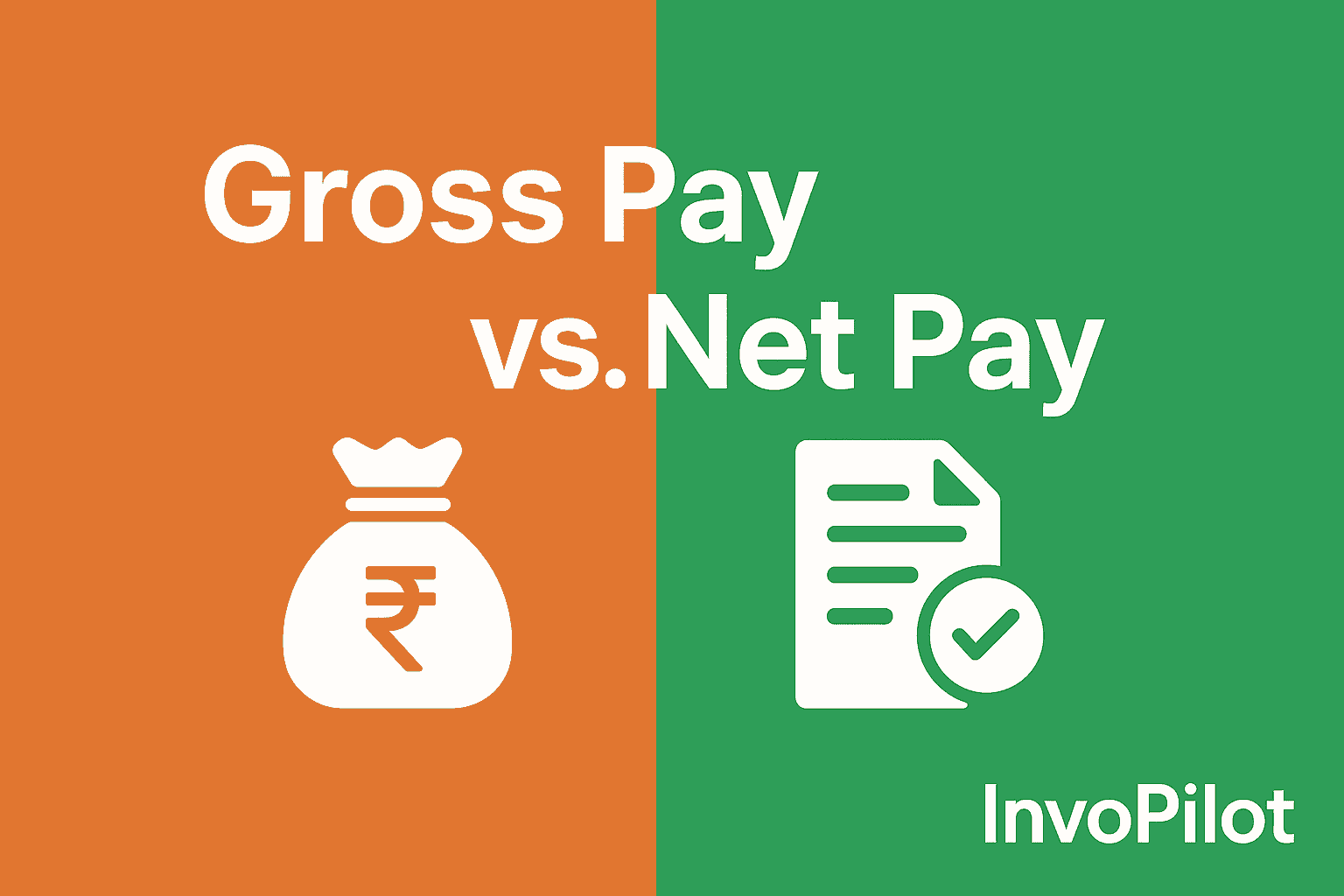


To make it easier for both employers and employees, InvoPilot offers a free online calculator that helps you estimate your gross and net salary instantly.
Understanding your paycheck is more than just looking at the final amount deposited into your bank account. It’s important to know the difference between gross pay and net pay, as it directly affects your financial planning, tax calculations, and overall earnings. Whether you’re an employee trying to decode your salary slip or a business owner preparing accurate payroll, this guide will help you grasp the critical differences between gross and net income.
Gross pay is the total amount of money an employee earns before any deductions are made. It includes:
Base salary or hourly wage
Bonuses and commissions
Overtime pay
Holiday pay
Allowances (HRA, travel, etc.)
For example, if you earn ₹50,000 per month, along with ₹5,000 in performance bonuses, your gross pay is ₹55,000.
For salaried employees:
Gross Pay = Monthly Salary + Bonuses + Allowances + Overtime
For hourly workers:
Gross Pay = (Hourly Rate × Hours Worked) + Overtime + Commissions
Net pay, often called take-home pay, is the amount an employee actually receives after all deductions are subtracted from gross income. These deductions may include:
Income tax
Provident Fund (PF) contributions
Professional tax
Health insurance premiums
Loan EMIs or salary advances
If your gross salary is ₹55,000 and your deductions total ₹10,000, then your net pay is ₹45,000.
Net Pay = Gross Pay – Total Deductions
| Feature | Gross Pay | Net Pay |
|---|---|---|
| Definition | Total earnings before deductions | Final amount after deductions |
| Includes | Salary, bonuses, allowances | Only the payable amount |
| Visibility | Appears at the top of payslip | Appears at the bottom of payslip |
| Employer Use | For calculating payroll expenses | For actual payment to employee |
| Employee Use | For loan/credit eligibility | For budgeting and savings |
Helps with budgeting and financial planning
Essential for understanding tax liabilities
Useful when negotiating salary packages
Crucial for accurate payroll processing
Helps in maintaining legal compliance
Impacts employee satisfaction
Let’s say you earn:
Base Salary: ₹40,000
HRA: ₹5,000
Bonus: ₹5,000
Total Gross Pay = ₹50,000
Deductions:
PF: ₹2,000
Tax: ₹3,000
Insurance: ₹500
Total Deductions = ₹5,500
Net Pay = ₹50,000 – ₹5,500 = ₹44,500
This breakdown shows how your gross income transitions to the actual amount you receive each month.
To make it easier for both employers and employees, InvoPilot offers a free online calculator that helps you estimate your gross and net salary instantly. It’s especially useful for HR departments, freelancers, and contractors to plan their payments accurately.
Managing payroll manually can be time-consuming and error-prone. That’s why platforms like InvoPilot simplify the process by offering powerful tools for invoice generation, salary management, and deduction tracking—all in one place.
Need a professional invoice for services rendered? Try the free invoice generator built by InvoPilot to create and send polished invoices in minutes.
Whether you’re calculating your paycheck or managing a team’s payroll, understanding the difference between gross pay and net pay is essential. Gross pay gives a picture of total earnings, while net pay reveals what you actually take home. Both figures are crucial for planning, compliance, and transparency.
With tools like InvoPilot, you can streamline salary calculations, generate invoices, and ensure financial clarity—for yourself or your business.
Health insurance premiums
Key Differences Summarized:
|
Feature
|
Gross Pay
|
Net Pay
|
|---|---|---|
|
Definition
|
Total earnings before deductions
|
Earnings after deductions
|
|
Calculation
|
Total earnings
|
Gross Pay – Deductions
|
|
Take-home?
|
No
|
Yes
|
|
Taxable?
|
Yes
|
Yes
|
|
Used for
|
Benefits, tax calculations
|
Budgeting, expenses
|
